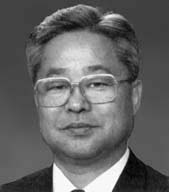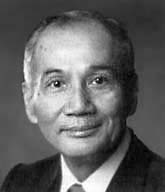“Church Progress Continues in Japan and South Korea,” Ensign, May 1994, 111–12
Church Progress Continues in Japan and South Korea
Japan and South Korea are known for their strong work ethic and family orientation. To learn how the Church is prospering in the two nations, the Ensign talked with Elder Merrill J. Bateman of the Seventy, when he was president of the Asia North Area, and with his counselors, Elders In Sang Han and Sam K. Shimabukuro, also of the Seventy, prior to Elder Bateman’s call to serve as Presiding Bishop.



Elder In Sang Han Bishop Merrill J. Bateman Elder Sam K. Shimabukuro
Question: Can you tell us how the gospel is being received in Japan and South Korea?
Answer: A solid membership base has been established in both countries, with ninety thousand members, twenty-five stakes, and ten missions in Japan and forty-three thousand members, sixteen stakes, and four missions in South Korea. Quality leadership exists in both countries, and an excellent infrastructure is in place, with almost 250 chapels and two temples—one in Tokyo, Japan, and the other in Seoul, South Korea. The Church has a strong foundation upon which to build.
Member activity has been increasing at a rate of 4 percent per year for the last decade, as measured by sacrament meeting attendance. This is an excellent rate of growth and reflects the faithfulness of the membership. Japanese and South Korean Saints are willing to introduce the gospel to their friends and family members, and we believe that conversions will accelerate during the 1990s, given the faithfulness of the Saints.
Japan and South Korea are jewels in the Pacific Rim. We see both countries eventually fulfilling President Kimball’s vision of providing the base for missionary work in eastern Russia and China. Church development in the area has not quite reached that point yet, but the day is not far off.
Q: In what ways do South Korean and Japanese Saints manifest their commitment to the Lord?
A: One indication of their commitment and strength is the number of families being home taught by active Melchizedek Priesthood brethren. On average, each pair of Japanese home teachers visits three families per month, while the South Korean brethren visit four families. One Japanese stake averages ten families taught by each pair of home teachers. They are extremely well organized. The Japanese and South Korean sisters are making a concerted effort as well. With respect to visiting teaching, both the Japanese and Korean sisters contact or visit three to four sisters monthly. These visits occur in spite of high costs, both in terms of travel time and money.
Another measure of commitment is the tithing and fast offering faithfulness of the Saints. The Japanese members are very close to being financially self-sufficient, as their contributions cover practically all of the costs of Church operations in the country. We expect that self-sufficiency in South Korea will be reached near the end of the decade.
Q: What are the kinds of challenges facing Church members and investigators?
A: Both countries are inhabited by hard-working people. Children spend five and one-half days in school each week, and in addition, many of them attend night school. For example, many children return home from school at 5:00 P.M. and are back in school from 6:00 P.M. to 9:00 P.M. in preparation for the eventual university entrance examinations, which are highly competitive. School activities are generally held on Sunday. For the youth of the Church, that becomes a special challenge. They are forced to choose between school sports, drama, and other activities and attending Church meetings on Sunday. Fortunately, most of the youth have strong testimonies and are committed to the gospel. The majority stay close to the Church by limiting their participation in school activities. The faith of the youth is reflected in seminary attendance, which exceeds 50 percent in many areas.
Most adults in Japan and Korea work five and one-half to six days per week and ten to twelve hours per day. Male workers generally are not home until 8:00 P.M. or 9:00 P.M. That presents a challenge in teaching and converting families. It is difficult to find men at home during the normal teaching hours. However, there are success stories.
Recently, two missionaries were teaching a family except for the father. He worked on a construction site from 6:00 A.M. to 10:00 P.M. seven days a week. The missionaries decided to visit the father at the work site.
In hopes of getting rid of the missionaries, he agreed to return home early one evening at 7:00 P.M. so they could talk with him. For the first time in years, he was able to have a meal with his family. During the meal, his wife began to cry, and he realized how much his being home meant to her and the children. He decided to change his work pattern, and the family has since joined the Church.
Unemployment has not been a problem in Japan until recently. For the first time since World War II, Japan is in the midst of an economic crisis. The current economic recession in Japan may help missionary work. The recession is forcing people to examine their values and goals. A newspaper reporter recently interviewed a number of Japanese people regarding their views of the future. Many commented that the recession has forced them to question their values, that life should be more than just working from morning until night. Some of those interviewed spoke of the need for the encouragement on a regular weekly basis that some religions, specifically Christianity, provide.
Q: Does the demand for higher education limit the availability of young men to serve missions?
A: The Japanese and South Korean circumstances are different. In Japan, a young man can begin university at age eighteen or nineteen, take a sabbatical leave for two years, and then return without losing his position at the university. Consequently, most second- or third-generation Japanese Latter-day Saint brethren and sisters enter the mission field as soon as they reach the appropriate age. Most of the native missionaries in Japan are still the first generation of Latter-day Saints in their families, however, and they are twenty-two or twenty-three years old before entering the field.
Korean university students are not allowed to take more than a one-year sabbatical from school. If a young man leaves the university for longer than one year, he loses his university standing and has to retake the entrance examination and qualify all over again. In addition, South Korean men are required to serve for thirty months in the military. Consequently, many young South Korean brethren are not available for missions until their twenty-fifth or twenty-sixth birthdays. However, most still desire to serve a mission, and they are encouraged to do so.
About 20 percent of the missionaries in both countries are native. One of the Church’s strengths in the Asia North Area is the growing force of returned missionaries, which numbers more than two thousand in Japan and one thousand in South Korea. They are becoming a prime source of leadership in the stakes and districts.
Q: How do members in the area deal with demands on their time?
A: Active members exhibit incredible faith in their decision to participate fully in the Church. Some have changed their jobs or have accepted lower-paying positions so that they may have time to devote to Church callings. Both societies indirectly put pressure on people not to join the Church or not to participate fully. A spiritual witness is critical to any conversion, but it is especially important in these two countries if a member is to remain active over a lifetime.
Q: Are there other challenges?
A: One of the differences between Japan and South Korea is that Japan is only 2 percent Christian, whereas South Korea is 35 percent Christian. Most Japanese know little about Christianity and almost nothing about the Church. One of the key challenges is teaching them the plan of salvation with a special emphasis on the Savior and the Atonement.
Japan and Korea are relatively homogeneous societies. The Japanese, in particular, are not used to foreign influences. There is a lot of societal pressure to be loyal to the institutions that are pure Japanese. Although we consider ourselves a worldwide church, the Japanese consider the Church a foreign institution. For most people, time is required for their hearts to soften so the Spirit can work with them.
We expect the Church’s family history program will become a major factor in opening doors in both countries. Both the Japanese and Koreans have strong feelings for their ancestors and are family oriented. Family history can become an important tool in building common links between the Church and the people. At this point in time, most Japanese and Koreans know little about the Church’s vast family history effort. They don’t know of the strong feelings we have for our ancestors. Family history has considerable potential in advancing the growth of the Church in Asia.
We are encouraged. We see great potential and possibilities for the Church in Japan and South Korea. We expect a dynamic decade ahead.

Map of Japan and South Korea